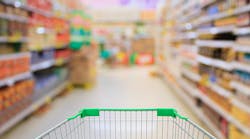Imports, Retail Sales and Economy Should All Improve in 2017
Imports at the nation’s major retail container ports are expected to increase 4.6% during the first half of 2017 over the same period last year as the nation’s economy improves and retail sales continue to grow, according to the monthly Global Port Tracker report produced by the National Retail Federation and consulting firm Hackett Associates.
“This is very much in line with what we are forecasting for retail sales and consumer spending this year,” says Jonathan Gold, NRF’s vice president for supply chain and customs policy. “Retailers try to balance inventories very carefully with demand. So, when retailers import more merchandise, that’s a pretty good indicator of what they are expecting to happen with sales.”
Ports covered by Global Port Tracker handled 1.58 million twenty-foot equivalent units (TEUs) in December, the latest month for which after-the-fact numbers are available. That was down 3.8% from November as the holiday season came to an end but up 10.2% from December 2015. That brought 2016 cargo volume to a total of 18.8 million TEUs, up 3.2% from 2015, which had grown 5.4% from 2014. One TEU is one 20-foot-long cargo container or its equivalent.
January was estimated at 1.59 million TEUs, up 6.6% from January 2016. February is forecast at 1.53 million TEUs, down 0.6% from last year; March at 1.43 million TEUs, up 7.8% from last year; April at 1.56 million TEUs, up 8.2%; May at 1.66 million TEUs, up 2.3%, and June at 1.65 million TEUs, up 4.3%.
Those numbers would bring the first half of 2017 to 9.4 million TEUs, up 4.6% from the first half of 2016. That would be almost three times the 1.6% growth seen in the first half of 2016 over the same period in 2015.
The cargo numbers come a day after NRF forecast that 2017 retail sales—excluding automobiles, gasoline and restaurants—will increase between 3.7% and 4.2% over 2016, citing job and income growth and low debt that show “the fundamentals are in place.”
Cargo volume does not correlate directly to sales because only the number of containers is counted, not the value of the cargo inside, but nonetheless provides a barometer of retailers’ expectations.
“The United States is well placed in 2017 and is likely to outperform most of the rest of the developed economies,” says Ben Hackett, founder of Hackett Associates. “If the infrastructure investments promised by the new administration come about, we can expect stronger growth than in 2016, but that assumes good relationships with U.S. trading partners and no recourse to trade barriers that would result in a tit-for-tat response.
